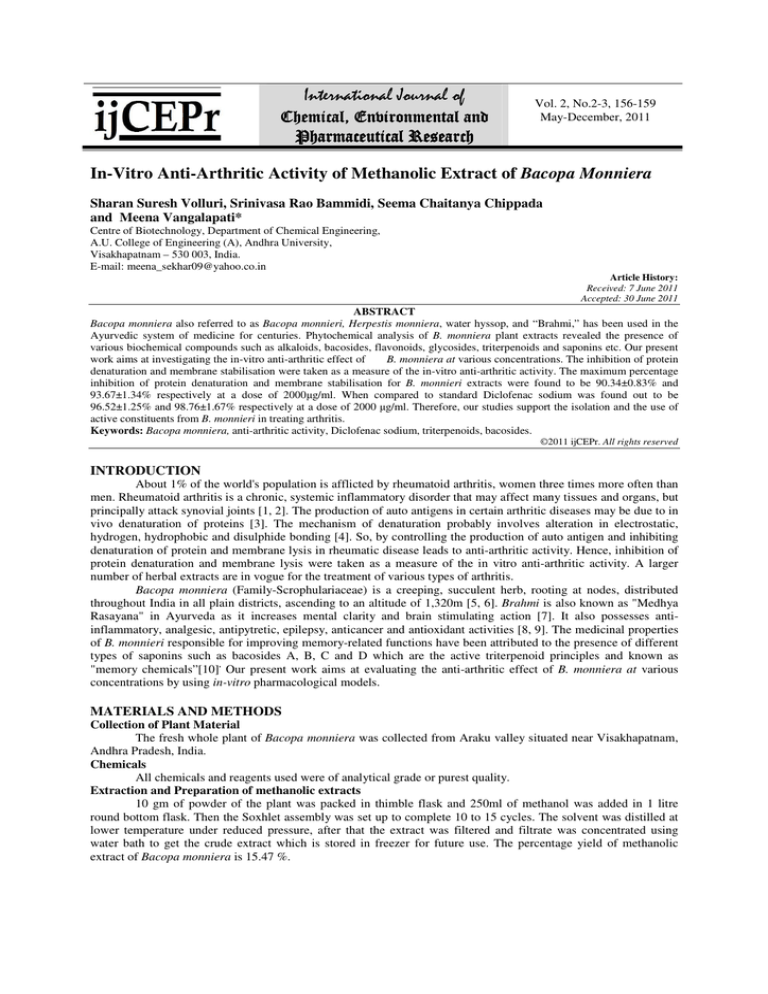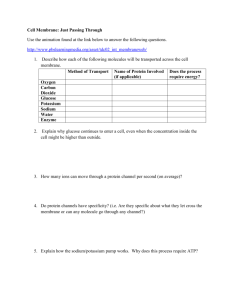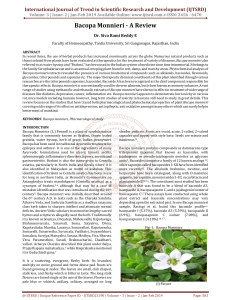
International Journal of
Chemical, Environmental and
Pharmaceutical Research
Vol. 2, No.2-3, 156-159
May-December, 2011
In-Vitro Anti-Arthritic Activity of Methanolic Extract of Bacopa Monniera
Sharan Suresh Volluri, Srinivasa Rao Bammidi, Seema Chaitanya Chippada
and Meena Vangalapati*
Centre of Biotechnology, Department of Chemical Engineering,
A.U. College of Engineering (A), Andhra University,
Visakhapatnam – 530 003, India.
E-mail: meena_sekhar09@yahoo.co.in
Article History:
Received: 7 June 2011
Accepted: 30 June 2011
ABSTRACT
Bacopa monniera also referred to as Bacopa monnieri, Herpestis monniera, water hyssop, and “Brahmi,” has been used in the
Ayurvedic system of medicine for centuries. Phytochemical analysis of B. monniera plant extracts revealed the presence of
various biochemical compounds such as alkaloids, bacosides, flavonoids, glycosides, triterpenoids and saponins etc. Our present
work aims at investigating the in-vitro anti-arthritic effect of
B. monniera at various concentrations. The inhibition of protein
denaturation and membrane stabilisation were taken as a measure of the in-vitro anti-arthritic activity. The maximum percentage
inhibition of protein denaturation and membrane stabilisation for B. monnieri extracts were found to be 90.34±0.83% and
93.67±1.34% respectively at a dose of 2000µg/ml. When compared to standard Diclofenac sodium was found out to be
96.52±1.25% and 98.76±1.67% respectively at a dose of 2000 µg/ml. Therefore, our studies support the isolation and the use of
active constituents from B. monnieri in treating arthritis.
Keywords: Bacopa monniera, anti-arthritic activity, Diclofenac sodium, triterpenoids, bacosides.
©2011 ijCEPr. All rights reserved
INTRODUCTION
About 1% of the world's population is afflicted by rheumatoid arthritis, women three times more often than
men. Rheumatoid arthritis is a chronic, systemic inflammatory disorder that may affect many tissues and organs, but
principally attack synovial joints [1, 2]. The production of auto antigens in certain arthritic diseases may be due to in
vivo denaturation of proteins [3]. The mechanism of denaturation probably involves alteration in electrostatic,
hydrogen, hydrophobic and disulphide bonding [4]. So, by controlling the production of auto antigen and inhibiting
denaturation of protein and membrane lysis in rheumatic disease leads to anti-arthritic activity. Hence, inhibition of
protein denaturation and membrane lysis were taken as a measure of the in vitro anti-arthritic activity. A larger
number of herbal extracts are in vogue for the treatment of various types of arthritis.
Bacopa monniera (Family-Scrophulariaceae) is a creeping, succulent herb, rooting at nodes, distributed
throughout India in all plain districts, ascending to an altitude of 1,320m [5, 6]. Brahmi is also known as "Medhya
Rasayana" in Ayurveda as it increases mental clarity and brain stimulating action [7]. It also possesses antiinflammatory, analgesic, antipytretic, epilepsy, anticancer and antioxidant activities [8, 9]. The medicinal properties
of B. monnieri responsible for improving memory-related functions have been attributed to the presence of different
types of saponins such as bacosides A, B, C and D which are the active triterpenoid principles and known as
"memory chemicals”[10]. Our present work aims at evaluating the anti-arthritic effect of B. monniera at various
concentrations by using in-vitro pharmacological models.
MATERIALS AND METHODS
Collection of Plant Material
The fresh whole plant of Bacopa monniera was collected from Araku valley situated near Visakhapatnam,
Andhra Pradesh, India.
Chemicals
All chemicals and reagents used were of analytical grade or purest quality.
Extraction and Preparation of methanolic extracts
10 gm of powder of the plant was packed in thimble flask and 250ml of methanol was added in 1 litre
round bottom flask. Then the Soxhlet assembly was set up to complete 10 to 15 cycles. The solvent was distilled at
lower temperature under reduced pressure, after that the extract was filtered and filtrate was concentrated using
water bath to get the crude extract which is stored in freezer for future use. The percentage yield of methanolic
extract of Bacopa monniera is 15.47 %.
Vol.2, No.2-3, 156-159(2011)
Inhibition of Protein Denaturation
The following procedure was followed for evaluating the percentage of inhibition of protein denaturation1. Test solution (0.5ml) consist of 0.45ml of Bovine serum albumin (5%W/V aqueous solution) and 0 .05ml of test
solution.
2. Test control solution (0.5ml) consist of 0.45ml of bovine serum albumin (5%W/V aqueous solution) and 0
.05ml of distilled water.
3. Product control (0.5ml) consists of 0.45ml of distilled water and 0.05 ml of test solution.
4. Standard solution (0.5ml) consists of 0.45ml of Bovine serum albumin (5%w/v aqueous solution) and 0.05ml 0f
Diclofenac sodium.
Various concentrations (50, 100, 250, 500, 1000, 2000 µg/ml) of plant extracts (test solution) and diclofenac sodium
(standard) of were taken respectively. All the above solutions were adjusted to pH 6.3 using 1N HCl. The samples
were incubated at 37°c for 20 minutes and the temperature was increased to keep the samples at 57°c for 3 minutes.
After cooling, add 2.5 ml of phosphate buffer to the above solutions. The absorbance was measured using UVVisible spectrophotometer at 416nm.
The control represents 100% protein denaturation. The results were compared with Diclofenac sodium. The
percentage inhibition of protein denaturation of different concentrations was tabulated in Table 1 & Figure 1.
The percentage inhibition of protein denaturation can be calculated as% of Inhibition = [100 - (O.D of test solution – O.D of product control)] X 100.
(O.D of test control)
The control represents 100% protein denaturation .The results were compared with Diclofenac sodium.
Effect on membrane stabilisation / Inhibition of membrane lysis
The principle involved here is stabilization of human red blood cell (HRBC) membrane by hypo tonicity
induced membrane lysis. The assay mixture contains 1ml phosphate buffer [pH 7.4, 0.15 M], 2 ml hypo saline [0.36
%], 0.5 ml HRBC suspension [10% v/v] with 0.5 ml of plant extracts and standard drug diclofenac sodium of
various concentrations (50, 100, 250, 500, 1000, 2000 µg/ml) and control (distilled water instead of hypo saline to
produce 100 % hemolysis) were incubated at 37oC for 30 min and centrifuged respectively. The haemoglobin
content in the suspension was estimated using spectrophotometer at 560 nm. The percentage of membrane
stabilisation at different concentrations was tabulated in Table 1 and shown in Figure 2.
The percentage inhibition of membrane stabilisation can be calculated as% of Inhibition = 100 - [(O.D of test solution) ÷ (O.D of control) × 100].
Table-1: Effect of B. monniera and Diclofenac sodium on inhibition of protein denaturation and membrane
stabilisation.
Concentration
(µg/ml)
% Inhibition of protein
denaturation by
B. monniera
% Inhibition of protein
denaturation by
Diclofenac sodium
% of membrane
stabilisation of
B. monniera
50
100
250
500
1000
2000
60.34±1.08
65.23±1.22
73.16±2.02
82.95±1.99
85.66±1.34
90.34±0.83
64.81±1.47
70.54±1.58
81.32±1.83
85.67±0.63
92.78±1.69
96.52±1.25
64.54±1.77
74.37±0.85
80.32±1.83
83.94±1.37
90.84±0.77
93.67±1.34
% of membrane
stabilisation of
Diclofenac
sodium
52.81±1.75
76.54±1.94
81.32±0.89
85.67±1.56
92.58±1.34
98.76±1.67
Each value represents means ± SD (n=3).
RESULTS AND DISCUSSIONS
The methanolic extract of B. monniera has showed significant activity at various concentrations and its
effect was compared with the standard drug Diclofenac sodium. The maximum percentage inhibition of protein
denaturation and membrane stabilisation of B. monniera was observed as 90.34±0.83% and 93.67±1.34% at
2000µg/ml respectively as shown in Table 1. When compared to standard Diclofenac sodium was found out to be
157
Vol.2, No.2-3, 156-159(2011)
96.52±1.25% and 98.76±1.67% respectively at a dose of 2000µg/ml. The production of auto antigen in certain
arthritic disease may be due to denaturation of protein and membrane lysis. From the results (Figure 1 and 2) of our
present study, it can be stated that methanolic extracts are capable of controlling the production of auto antigen and
inhibits denaturation of protein and membrane lysis in rheumatic disease.
Fig.-1: Effect of B. monniera and diclofenac sodium on percentage inhibition of protein denaturation
Fig.-2: Effect of B. monniera and diclofenac sodium on percentage of membrane stabilisation
CONCLUSION
Inhibition of protein denaturation and membrane stabilisation was studied to establish the mechanism of
anti‐arthritic effect of B. monnieri. Therefore, our present in-vitro studies on B. monnieri extracts demonstrated the
significant anti-arthritic activity. Due to the presence of active principles such as flavonoids, bacosides and
tritrepenoids and related polyphenols may responsible for this activity. Hence, B. monnieri can be used as a potent
anti-arthritic agent.
REFERENCES
1.
2.
3.
4.
Majithia V., Geraci S.A., Am. J. Med., 120 (11) (2007) 936
Westwood O.M., Nelson P.N., Hay F.C., Rheumatology (Oxford), 45 (4) (2006) 379
Brown J.H., Mackey H.K., Proc Soc Exp Biol Med, 128 (1968) 225
Grant N.H., Alburn H.E., Kryzanauskas C., Biochem Pharmacol, 19 (1970) 715
158
Vol.2, No.2-3, 156-159(2011)
5.
Anonymous. Indian Herbal Pharmacopoeia, vol. I Mumbai, India. Indian Drug Manufactures Association
(1998) 30
6. Chatterjee A., The Treatise of Indian Medicinal Plants, National Institute of Science and Communication
CSIR, New Delhi ,4 (1997) 212
7. Bhattacharya S.K., Ghosal S., Phytomed., 5 (1998) 77
8. Satyavati G.V., Raina M.K., Sharma M., Indian medicinal plants. ,Vol. 1 Indian Council of Medical
Research, New Delhi (1976) 20
9. Chopra R.N., Nayar S.L., Chopra I.C., Glossary of Indian Medicinal plants, New Delhi, India. National
Institute of Science and Communication (CSIR) (1986) 32
10. Rastogi S., Mehrotra B.N. and Kulshreshtha D.K., Proceedings of IV International Congress of
Ethnobiology. Deep Publications, New Delhi (1994) 93
[IJCEPR-156/2011]
International Journal of
Chemical, Environmental and Pharmaceutical Research
www.ijcepr.com
ISSN: 2229-3892(Print); ISSN: 2229-5283(Online)
[Abstracted in : Chemical Abstracts Service , American Chemical Society, USA and CAB(I) , UK]
________________________________________________________________________________________________________
ijCEPr widely covers all fields of Chemical, Environmental and Pharmaceutical Research.
Manuscript Categories: Full-length paper, Review Articles, Short/Rapid Communications.
Manuscripts should be addressed to:
E-mail: ijcepr@gmail.com
Absolutely FREE*
[For New life Members]
The Challenges of a Changing
World: Perspective of Nigerian
Women Scientists in
Chemical, Environmental and
Pharmaceutical Research
Be a Proud Life Member of
RASĀYAN J. Chem.
Life Membership for Individuals: Rs.8000/- for Indians and USD 1000 for others.
Life Membership for Institutional: Rs.10000/- for Indians and USD 1500 for others.
BENEFITS OF LIFEMEMBERSHIP:
1. You will receive the journal and all its special issues regularly
lifelong.
2. If you are a LIFE MEMBER, you need not to pay subscription fee
every time for publication of your paper in RJC.
3. You’ll be a Reviewer for RJC manuscripts of your Field Interest
and we’ll publish your name in our journal.
4. You will be exempted from Registration Fee of any National or
International future events (i.e. workshop, seminars, Conferences
etc.) organized by RJC.
5. You may be elected as Editorial Member of RJC (Note: It’ll depend
upon your publication and scientific achievements).
6. New Life members shall have a BOOK* absolutely FREE from
RJC with Complements.
For being a Life Membership, just mail to editor-in-Chief with your
detailed Resume.
Correspondence address:
[ISBN: 978-81-921149-0-3]
Print Price: Rs. 990/- only
23 ‘Anukampa’, Janakpuri, Opp. Heerapura Power Stn., Ajmer Road, Jaipur-302024 (India)
E-mail : rasayanjournal@gmail.com ; Phone : 0141-2810628(Off.), 07597925412(Mob.)
159






